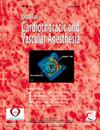脓毒症和脓毒性休克中脓毒性心肌病的诊断工具和患病率: 一项前瞻性试点研究
IF 2.3
4区 医学
Q2 ANESTHESIOLOGY
Journal of cardiothoracic and vascular anesthesia
Pub Date : 2024-10-25
DOI:10.1053/j.jvca.2024.09.028
引用次数: 0
摘要
目的心血管损伤是败血症的常见并发症,发生率为 10%-70%。脓毒症心肌病(SCM)发生在重症监护病房,是脓毒症患者心肌的一种可逆性损伤。尽管提出了多种诊断工具,但没有一种是专门针对 SCM 的。本研究旨在评估不同的超声心动图诊断工具,并确定我国人群中的 SCM 发生率。设计与方法 2024 年 3 月至 5 月,在一家三级参考医院开展了一项单中心前瞻性观察研究。研究对象包括符合败血症-3 标准、年龄在 18 岁以上、在重症监护室接受治疗的患者。研究获得了地区伦理委员会的伦理批准。经胸超声心动图(TTE)和血液动力学测量在患者确认后 48 小时内进行,并在 10 天内重复进行。脓毒性心肌病(SCMP)的诊断使用三种不同的诊断工具进行评估:左室射血分数(LVEF <50%或>比基线下降10%)、心脏动力输出(CPO <0.6W)和与后负荷相关的心脏性能(ACP <80%),以文献报道的数值为基础。从电子病历中提取了人口统计学和描述性数据:38名患者(平均年龄61±13岁;63.2%为男性)入组。中位 SOFA 评分为 9.5 [IQR,8-11],APACHE II 评分为 19 [16-22],SAPS II 评分为 42 [32-51]。乳酸水平中位数为 3.1 [2.1-4.9] mmol/L,白细胞计数为 16 [12-21] x10^9/L,PCT 为 11.2 [3.5-31.7] ng/mL,CRP 为 300 [179-407] mg/L,肌钙蛋白 I 为 214 [47-627] ng/L。在根据 LVEF 诊断为 SCMP 的患者中,7 人(19.4%)患有 SCMP,其速度时间积分明显较低(VTI:13.2±3.3 vs 18.1±4.7cm,P<0.05)。1±4.7厘米,P=0.013)和搏出量(SV:50.4±13.8 vs 67.7±18.5毫升,P=0.026),心率(HR:106±14 vs 87±20bpm,P=0.028)较非SCMP患者(31人,80.6%)高。对于基于 CPO 的诊断,6 名患者(20.7%)患有 SCMP,其 VTI(13.2±2.8 vs 17.9±4.9,p=0.029)、SV(47.2±11.5 vs 67.5±18.5ml,p=0.015)和心输出量(CO:3.9±0.5 vs 6.1±1.7 L/min,p<0.001),与 29 例非 SCMP 患者相比,心脏指数呈下降趋势(CI:1.7±0.5 vs 2.6±0.8 L/min/m2,p=0.07)。基于 ACP 的 SCMP 患病率高于 LVEF 或 CPO 组,有 18 名患者(51.4%)被诊断为 SCMP。其中 17 名患者心功能轻度受限(ACP 60-80%),1 名患者心功能中度受限(ACP 40-60%)。相比之下,基于 ACP 的 SCMP 患者的平均动脉压(MAP:98±17 vs 109±12 mmHg,P=0.025)、CI(2.2±0.7 vs 2.8±0.8 l/min/m2,P=0.011)、CO(4.6 [4.0-5.5] vs 6.4 [5.5-7.1] L/min,p=0.005)和 SV(55 [43-66] vs 70 [59-82] ml,p=0.013),但中心静脉压(CVP:15±6 vs 11±6 mmHg,p=0.032)高于 17 名非 SCMP 患者。在乳酸水平、VIS 评分和存活率方面,SCMP 组和非 SCMP 组无明显差异。要确定单核细胞增多症的最佳诊断工具,还需要进行进一步的分析,这需要更大的样本群。本文章由计算机程序翻译,如有差异,请以英文原文为准。
Diagnostic Tools and Prevalence of Septic Cardiomyopathy in Sepsis and Septic Shock: A Prospective Pilot Study
Objective
Cardiovascular damage is a common complication of sepsis, with an incidence of 10% to 70%. Septic cardiomyopathy (SCM) occurs in ICUs as a reversible myocardial damage in sepsis patients. Despite various proposed diagnostic tools, none are specifically tailored for SCM. This study aims to evaluate different echocardiography-based diagnostic tools and determine the SCM rate in our population.
Design and method
A single-centre, prospective observational study was conducted at a tertiary reference hospital from March to May 2024. Patients meeting Sepsis-3 criteria, aged over 18 years, and treated in the ICU were included. Ethical approval was obtained from the regional ethical committee. Transthoracic echocardiogram (TTE) and hemodynamic measurements were performed within 48 hours of patient identification and repeated within 10 days. A diagnosis of septic cardiomyopathy (SCMP) was evaluated using three different diagnostic tools: left ventricular ejection fraction (LVEF <50% or >10% decrease from baseline), cardiac power output (CPO <0.6W), and afterload-related cardiac performance (ACP <80%) based on values reported in the literature. Demographic and descriptive data were extracted from electronic medical records.
Results and conclusions
Results: Thirty-eight patients (mean age 61±13 years; 63.2% males) were enrolled. The median SOFA score was 9.5 [IQR, 8-11], APACHE II score 19 [16-22], and SAPS II 42 [32-51]. Median lactate levels were 3.1 [2.1-4.9] mmol/L, WBC count 16 [12-21] x10^9/L, PCT 11.2 [3.5–31.7] ng/mL, CRP 300 [179-407] mg/L, and troponin I 214 [47-627] ng/L. The median time between TTEs was 6 [4-9] days.
In patients diagnosed with SCMP based on LVEF, seven (19.4%) had SCMP, showing significantly lower velocity time integral (VTI: 13.2±3.3 vs 18.1±4.7 cm, p=0.013) and stroke volume (SV: 50.4±13.8 vs 67.7±18.5 ml, p=0.026), and higher heart rate (HR: 106±14 vs 87±20 bpm, p=0.028) compared to non-SCMP patients (n=31, 80.6%). For CPO-based diagnosis, six patients (20.7%) had SCMP, with significantly lower VTI (13.2±2.8 vs 17.9±4.9, p=0.029), SV (47.2±11.5 vs 67.5±18.5 ml, p=0.015), and cardiac output (CO: 3.9±0.5 vs 6.1±1.7 L/min, p<0.001), and a trend towards lower cardiac index (CI: 1.7±0.5 vs 2.6±0.8 L/min/m2, p=0.07) compared to twenty-nine non-SCMP patients. The prevalence of SCMP based on ACP was higher than in the LVEF or CPO group, with eighteen patients (51.4%) diagnosed with SCMP. Seventeen patients had slightly restricted cardiac function (ACP 60-80%) and one had moderately restricted cardiac function (ACP 40-60%). Comparatively, ACP-based SCMP patients had significantly lower mean arterial pressure (MAP: 98±17 vs 109±12 mmHg, p=0.025), CI (2.2±0.7 vs 2.8±0.8 l/min/m2, p=0.011), CO (4.6 [4.0-5.5] vs 6.4 [5.5-7.1] L/min, p=0.005), and SV (55 [43-66] vs 70 [59-82] ml, p=0.013), but higher central venous pressure (CVP: 15±6 vs 11±6 mmHg, p=0.032) than the seventeen non-SCMP patients. No significant differences were observed in lactate levels, VIS score, and survival rates between SCMP and non-SCMP groups.
Conclusions
Based on the three diagnostic tools, the prevalence of SCM in our study group varied from 19.4% to 51.4% and did not differ from the rates reported in the literature. Further analysis is necessary to determine the best diagnostic tool for SCM, requiring a larger sample group.
求助全文
通过发布文献求助,成功后即可免费获取论文全文。
去求助
来源期刊
CiteScore
4.80
自引率
17.90%
发文量
606
审稿时长
37 days
期刊介绍:
The Journal of Cardiothoracic and Vascular Anesthesia is primarily aimed at anesthesiologists who deal with patients undergoing cardiac, thoracic or vascular surgical procedures. JCVA features a multidisciplinary approach, with contributions from cardiac, vascular and thoracic surgeons, cardiologists, and other related specialists. Emphasis is placed on rapid publication of clinically relevant material.

 求助内容:
求助内容: 应助结果提醒方式:
应助结果提醒方式:


